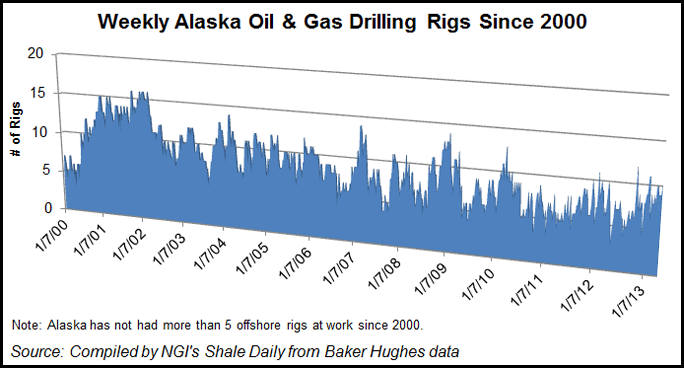NGI Archives | NGI All News Access
Alaska, Feds to Study State’s Unconventionals, Methane
The Alaska Department of Natural Resources (DNR) and the U.S. Department of Energy’s (DOE) Office of Fossil Energy on Tuesday inked an agreement at the LNG 17 conference in Houston to work together — and with potential investors — to dig down and study unconventional energy resources in Alaska’s Arctic.

The memorandum of understanding (MOU) was signed by DNR Commissioner Dan Sullivan and DOE Acting Assistant Secretary for Fossil Energy (FE) Christopher Smith, both of whom are speaking at the conference this week.
“This is a clear example of how the state and the federal government can work together on energy issues that will play a critical role in Alaska’s future,” said Sullivan. “As a state, we want to responsibly develop and commercialize all of the North Slope’s energy resources, which include gas hydrates, shale and viscous oil, and other unconventional energy resources. Simultaneously, the Department of Energy is strongly interested in demonstrating that these resources can be developed on an economic scale.”
Drilling in Alaska is currently a minor operation. According to Baker Hughes Inc. data, Alaska had 10 rigs drilling onshore and zero offshore for the week ending April 12. Since 2000, the most rigs drilling onshore at one time is 14, while the most drilling offshore is five.
Under the terms of the MOU, DNR commits to help DOE with its ongoing assessment of unconventional energy resources and field evaluation of potential unconventional energy production technologies on the North Slope, which includes facilitating access to state lands and assisting with permitting and logistical issues, as well as providing expert review and interpretation of scientific data and reports by the Division of Oil and Gas and Division of Geological and Geophysical Survey scientists.
“Forming good working relationships with state and local partners is critical to the Energy Department’s efforts to responsibly and sustainably develop all of America’s rich energy resources,” Smith said. “By establishing a framework for our continued work with the State of Alaska, we will advance America’s energy development and research, including our understanding of methane hydrates — a vast, untapped potential energy resource. And this agreement will help ensure Alaska continues to play a critical role in supplying America’s and the world’s energy needs.”
The DOE, through its National Energy Technology Laboratory, will have the lead role in developing research and development projects and providing scientific oversight of the field studies. DOE has committed to sharing the available technical data with the state.
“The Alaska DNR and DOE/FE may also endeavor together to highlight the potential of all of Alaska’s natural resources, including conventional resources such as natural gas, and unconventional resources such as gas hydrates and viscous oil, as important supply sources to meet domestic energy demands and to ensure domestic economic and energy security,” the agreement states.
Sullivan added that the MOU highlights all of the energy resources of Alaska — from the huge conventional resource fields and natural gas opportunities to onshore methane hydrate resources. “It is critical for the state and DOE work together to promote all of these opportunities. Responsible development of conventional resources today will support research advancements and unconventional breakthroughs in the future,” he said.
© 2024 Natural Gas Intelligence. All rights reserved.
ISSN © 2577-9877 | ISSN © 2158-8023 |

